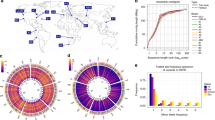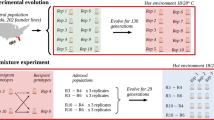Abstract
Complex behaviors are affected by multiple interacting loci with individually small and environmentally sensitive effects. Understanding the genetic architecture of behavioral traits begins with identifying the genes regulating these traits, mapping the subset of genetically varying quantitative trait loci (QTLs) in natural populations, and pinpointing the molecular polymorphisms defining QTL alleles. Drosophila brings an impressive toolkit to the challenge of genetically dissecting complex traits: P transposable element mutagenesis to identify genes regulating these traits; artificial selection from natural populations to create extreme trait phenotypes; high resolution mapping to identify positional candidate genes corresponding to QTLs; linkage disequilibrium mapping to identify molecular polymorphism(s) that functionally define QTL alleles; and whole genome transcriptional profiling to postulate networks of interacting genes affecting complex traits. Studies in Drosophila have revealed large numbers of pleiotropic genes that interact epistatically to regulate behavioral traits, and that can have sex- and environment-specific effects. These observations offer valuable lessons for understanding the genetic basis of variation for complex behaviors in other organisms, including humans.
Similar content being viewed by others
Abbreviations
- QTL:
-
Quantitative trait locus
- QTN:
-
Quantitative trait nucleotide
- SNP:
-
Single nucleotide polymorphism
- cM:
-
centi-Morgan
- LD:
-
Linkage disequilibrium
- GEI:
-
Genotype by environment interaction
References
Anholt RRH, Lyman RF, Mackay TFC (1996) Effects of single P element insertions on olfactory behavior in Drosophila melanogaster. Genetics 143:293–301
Anholt RRH, Dilda CL, Chang S, Fanara JJ, Kulkarni NH, Ganguly I et al (2003) The genetic architecture of odor-guided behavior in Drosophila: epistasis and the transcriptome. Nat Genet 35:180–184. doi:10.1038/ng1240
Baker BS, Taylor BJ, Hall JC (2001) Are complex behaviors specified by dedicated regulatory genes? Reasoning from Drosophila. Cell 105:13–24. doi:10.1016/S0092-8674(01)00293-8
Bellen HJ, Levis RW, Liao G, He Y, Carlson JW, Tsang G et al (2004) The BDGP gene disruption project: single transposon insertions associated with 40% of Drosophila genes. Genetics 167:761–781. doi:10.1534/genetics.104.026427
Carbone MA, Jordan KW, Lyman RF, Harbison ST, Leips J, DeLuca M et al (2006) Phenotypic variation and natural selection at Catsup, a pleiotropic quantitative trait gene in Drosophila. Curr Biol 16:912–919. doi:10.1016/j.cub.2006.03.051
De Luca M, Roshina NV, Geiger-Thornsberry GL, Lyman RF, Pasyukova EG, Mackay TFC (2003) Dopa-decarboxylase (Ddc) affects variation in Drosophila longevity. Nat Genet 34:429–433. doi:10.1038/ng1218
Edwards AC, Rollmann SM, Morgan TJ, Mackay TFC (2006) Quantitative genomics of aggressive behavior in Drosophila melanogaster. PLoS Genet 2(9):e154. doi:10.1371/journal.pgen.0020154
Falconer DS, Mackay TFC (1996) Introduction to quantitative genetics, 4/e. Addison-Wesley, Harlow Essex, UK
Fanara JJ, Robinson KO, Rollmann SM, Anholt RRH, Mackay TFC (2002) Vanaso is a quantitative trait locus for Drosophila olfactory behavior. Genetics 162:1321–1328
Fedorowicz GM, Fry JD, Anholt RRH, Mackay TFC (1998) Epistatic interactions between smell-impaired loci in Drosophila melanogaster. Genetics 148:1885–1891
Harbison ST, Yamamoto A, Fanara JJ, Norga KK, Mackay TFC (2004) Quantitative trait loci affecting starvation resistance in Drosophila melanogaster. Genetics 166:1807–1823. doi:10.1534/genetics.166.4.1807
Jordan KW, Morgan TJ, Mackay TFC (2006) Quantitative trait loci for locomotor behavior in Drosophila melanogaster. Genetics 174:271–284. doi:10.1534/genetics.106.058099
Jordan KW, Carbone MA, Yamamoto A, Morgan TJ, Mackay TFC (2007) Quantitative genomics of locomotor behavior in Drosophila melanogaster. Genome Biol 8:R172. doi:10.1186/gb-2007-8-8-r172
Long AD, Langley CH (1999) The power of association studies to detect the contribution of candidate genetic loci to variation in complex traits. Genome Res 9:720–731
Long AD, Mullaney SL, Mackay TFC, Langley CH (1996) Genetic interactions between naturally occurring alleles at quantitative trait loci and mutant alleles at candidate loci affecting bristle number in Drosophila melanogaster. Genetics 144:1497–1518
Long AD, Lyman RF, Langley CH, Mackay TFC (1998) Two sites in the Delta gene region contribute to naturally occurring variation in bristle number in Drosophila melanogaster. Genetics 149:999–1017
Lynch M, Walsh B (1998) Genetics and analysis of quantitative traits. Sinauer Sunderland, MA, USA
Mackay TFC (2001) The genetic architecture of quantitative traits. Annu Rev Genet 35:303–339. doi:10.1146/annurev.genet.35.102401.090633
Mackay TFC, Hackett JB, Lyman RF, Wayne ML, Anholt RRH (1996) Quantitative genetic variation of odor-guided behavior in a natural population of Drosophila melanogaster. Genetics 144:727–735
Mackay TFC, Heinsohn SL, Lyman RF, Moehring AJ, Morgan TJ, Rollmann SM (2005) Genetics and genomics of Drosophila mating behavior. Proc Natl Acad Sci USA 102:6622–6629. doi:10.1073/pnas.0501986102
Mackay TFC, Roshina NV, Leips J, Pasyukova EG (2006) Complex genetic architecture of Drosophila longevity. In: Masaro EJ, Austad SN (eds) Handbook of the biology of aging, 6th edn. Elsevier, New York, pp 181–216
Moehring AJ, Mackay TFC (2004) The quantitative genetic basis of male mating behavior in Drosophila melanogaster. Genetics 167:1249–1263. doi:10.1534/genetics.103.024372
Norga KK, Gurganus MC, Dilda CL, Yamamoto A, Lyman RF, Patel PH et al (2003) Quantitative analysis of bristle number in Drosophila mutants identifies genes involved in neural development. Curr Biol 13:1388–1397. doi:10.1016/S0960-9822(03)00546-3
Nuzhdin SV, Pasyukova EG, Dilda CL, Mackay TFC (1997) Sex-specific quantitative trait loci affecting longevity in Drosophila melanogaster. Proc Natl Acad Sci USA 94:9734–9739. doi:10.1073/pnas.94.18.9734
Pasyukova EG, Vieira C, Mackay TFC (2000) Deficiency mapping of quantitative trait loci affecting longevity in Drosophila melanogaster. Genetics 156:1129–1146
Robertson A (1967) The nature of quantitative genetic variation. In: Brink A (ed) Heritage from Mendel. University of Wisconsin, Madison, WI, USA, pp 265–280
Rollmann SM, Magwire MM, Morgan TJ, Özsoy ED, Yamamoto A, Mackay TFC et al (2006) Pleiotropic fitness effects of the Tre1/Gr5a region in Drosophila. Nat Genet 38:824–829. doi:10.1038/ng1823
Rollmann SM, Yamamoto A, Goossens T, Zwarts L, Callaerts P, Callaerts-Vegh Z et al (2007) The early neurodevelopmental gene Semaphorin 5c is essential for olfactory behavior in adult Drosophila. Genetics 176:947–956. doi:10.1534/genetics.106.069781
Sambandan D, Yamamoto A, Fanara JJ, Mackay TFC, Anholt RRH (2006) Dynamic genetic interactions determine odor-guided behavior in Drosophila melanogaster. Genetics 174:1349–1363. doi:10.1534/genetics.106.060574
Stathakis DG, Burton DY, McIvor WE, Krishnakumar S, Wright TR, O’Donnell JM (1999) The catecholamines up (Catsup) protein of Drosophila melanogaster functions as a negative regulator of tyrosine hydroxylase activity. Genetics 153:361–382
Storey JD, Tibshirani R (2003) Statistical significance for genomewide studies. Proc Natl Acad Sci USA 100:9440–9445. doi:10.1073/pnas.1530509100
Venken KJ, Bellen HJ (2005) Emerging technologies for gene manipulation in Drosophila melanogaster. Nat Rev Genet 6:167–178. doi:10.1038/nrg1553
Zeng ZB (1994) Precision mapping of quantitative trait loci. Genetics 136:1457–1468
Acknowledgements
This work was funded by National Institutes of Health grants R01 GM45146, R01 GM076083 and R01 AA016560 to Trudy Mackay, and R01 GM59469 to Robert Anholt. I thank my colleague, Robert Anholt, who co-directed much of this work and provides daily inspiration, and Hugo Bellen for the generous gift of the co-isogenic P{GT1} insert lines that were constructed in his laboratory. Many thanks also to the whole team who contributed to this work—you know who you are.
Author information
Authors and Affiliations
Corresponding author
Rights and permissions
About this article
Cite this article
Mackay, T.F.C. The genetic architecture of complex behaviors: lessons from Drosophila . Genetica 136, 295–302 (2009). https://doi.org/10.1007/s10709-008-9310-6
Received:
Accepted:
Published:
Issue Date:
DOI: https://doi.org/10.1007/s10709-008-9310-6




